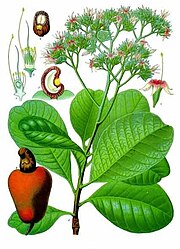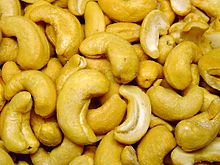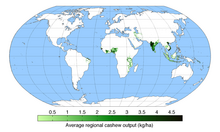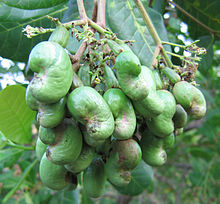Cashew: Difference between revisions
ClueBot NG (talk | contribs) m Reverting possible vandalism by 24.37.33.74 to version by BattyBot. False positive? Report it. Thanks, ClueBot NG. (1642607) (Bot) |
No edit summary |
||
| Line 18: | Line 18: | ||
}} |
}} |
||
The '''cashew''', scientific name '''''Anacardium occidentale''''', is a tree in the family [[Anacardiaceae]] which produces a seed that is harvested as the cashew nut. Its [[English language|English]] name derives from the [[Portuguese language|Portuguese]] name for the fruit of the cashew tree, ''caju'' ({{IPA-pt|kɐˈʒu}}), which itself is derived from the indigenous [[Tupian languages|Tupi]] name, ''acajú.'' Originally native to [[Northeast Region, Brazil|northeastern Brazil]], the tree is now widely grown in [[tropical climate]]s for its cashew apples and nuts. |
The '''cashew''', scientific name '''''Anacardium occidentale''''', is a tree in the family [[Anacardiaceae]] which produces a seed that is harvested as the cashew nut. Its [[English language|English]] name derives from the [[Portuguese language|Portuguese]] name for the fruit of the cashew tree, ''caju'' ({{IPA-pt|kɐˈʒu}}), which itself is derived from the indigenous [[Tupian languages|Tupi]] name, ''acajú.'' Originally native to [[Northeast Region, Brazil|northeastern Brazil]], the tree is now widely grown in [[tropical climate]]s for its cashew apples and nuts. The cashew come's from the fruit dude wake up! |
||
The cashew nut is a popular [[snack]] and food source. [[Nigeria]] was the world's largest producer of cashew nuts with shell in 2010. <ref name=fao2010a>{{cite web|url=http://faostat.fao.org/site/567/DesktopDefault.aspx?PageID=567#ancor |title=Major Food And Agricultural Commodities And Producers - Countries By Commodity |publisher=Fao.org |year= 2011|accessdate=2012-08-18}}</ref> |
The cashew nut is a popular [[snack]] and food source. [[Nigeria]] was the world's largest producer of cashew nuts with shell in 2010. <ref name=fao2010a>{{cite web|url=http://faostat.fao.org/site/567/DesktopDefault.aspx?PageID=567#ancor |title=Major Food And Agricultural Commodities And Producers - Countries By Commodity |publisher=Fao.org |year= 2011|accessdate=2012-08-18}}</ref> |
||
Revision as of 19:19, 7 January 2014
| Cashew Anacardium occidentale | |
|---|---|

| |
| Cashew fruit ready for harvest in Kollam, India | |
| Scientific classification | |
| Kingdom: | |
| (unranked): | |
| (unranked): | |
| (unranked): | |
| Order: | |
| Family: | |
| Genus: | |
| Species: | A. occidentale
|
| Binomial name | |
| Anacardium occidentale | |
The cashew, scientific name Anacardium occidentale, is a tree in the family Anacardiaceae which produces a seed that is harvested as the cashew nut. Its English name derives from the Portuguese name for the fruit of the cashew tree, caju (Portuguese pronunciation: [kɐˈʒu]), which itself is derived from the indigenous Tupi name, acajú. Originally native to northeastern Brazil, the tree is now widely grown in tropical climates for its cashew apples and nuts. The cashew come's from the fruit dude wake up!
The cashew nut is a popular snack and food source. Nigeria was the world's largest producer of cashew nuts with shell in 2010. [1]
Etymology
The name Anacardium actually refers to the shape of the fruit, which looks like an inverted heart (ana means "upwards" and -cardium means "heart"). In the Tupian languages, acajú means "nut that produces itself".[2]
Habitat and growth


The tree is large and evergreen, growing to 10-12m (~32 ft) tall, with a short, often irregularly shaped trunk. The leaves are spirally arranged, leathery textured, elliptic to obovate, 4 to 22 cm long and 2 to 15 cm broad, with smooth margins. The flowers are produced in a panicle or corymb up to 26 cm long, each flower is small, pale green at first, then turning reddish, with five slender, acute petals 7 to 15 mm long. The largest cashew tree in the world covers an area of about 7,500 square metres (81,000 sq ft), it's located in Natal, Rio Grande do Norte, Brazil.
The fruit of the cashew tree is an accessory fruit (sometimes called a pseudocarp or false fruit). What appears to be the fruit is an oval or pear-shaped structure, a hypocarpium, that develops from the pedicel and the receptacle of the cashew flower.[3] Called the cashew apple, better known in Central America as marañón, it ripens into a yellow and/or red structure about 5–11 cm long. It is edible, and has a strong "sweet" smell and a sweet taste. The pulp of the cashew apple is very juicy, but the skin is fragile, making it unsuitable for transport. In Latin America, a fruit drink is made from the cashew apple pulp which has a very refreshing taste and tropical flavor that can be described as having notes of mango, raw green pepper, and just a little hint of grapefruit-like citrus.
The true fruit of the cashew tree is a kidney or boxing-glove shaped drupe that grows at the end of the cashew apple. The drupe develops first on the tree, and then the pedicel expands to become the cashew apple. Within the true fruit is a single seed, the cashew nut. Although a nut in the culinary sense, in the botanical sense the nut of the cashew is a seed. The seed is surrounded by a double shell containing an allergenic phenolic resin, anacardic acid, a potent skin irritant chemically related to the better-known allergenic oil urushiol which is also a toxin found in the related poison ivy. Properly roasting cashews destroys the toxin, but it must be done outdoors as the smoke (not unlike that from burning poison ivy) contains urushiol droplets which can cause severe, sometimes life-threatening, reactions by irritating the lungs. People who are allergic to cashew urushiols may also react to mango or pistachio which are also in the Anacardiaceae family. Some people are allergic to cashew nuts, but cashews are a less frequent allergen than other nuts or peanuts.[4]
Dispersal
While native to northeast Brazil, the Portuguese took the cashew plant to Goa, India, between 1560 and 1565. From there it spread throughout Southeast Asia and eventually Africa.[5]
Cashew nut

Cashew nuts are a popular snack and food source. Cashews, unlike other oily tree nuts, contain starch to about 10% of their weight. This makes them more effective than other nuts in thickening water-based dishes such as soups, meat stews, and some Indian milk-based desserts. Many southeast Asian and south Asian cuisines use cashews for this unusual characteristic, rather than other nuts.[6]
The shell of the cashew nut is toxic, which is why the shell is removed before it is sold to consumers.[7]
Cashew nuts are commonly used in Indian cuisine, whole for garnishing sweets or curries, or ground into a paste that forms a base of sauces for curries (e.g., korma), or some sweets (e.g., kaju barfi). It is also used in powdered form in the preparation of several Indian sweets and desserts. In Goan cuisine, both roasted and raw kernels are used whole for making curries and sweets.

The cashew nut can also be harvested in its tender form, when the shell has not hardened and is green in color. The shell is soft and can be cut with a knife and the kernel extracted, but it is still corrosive at this stage, so gloves are required. The kernel can be soaked in turmeric water to get rid of the corrosive material before use. This is mostly found in Keralan cuisine, typically in avial, a dish that contains several vegetables, grated coconut, turmeric, and green chilies.
Cashew nuts are also used in Thai and Chinese cuisine, generally in whole form.
In the Philippines, cashew is a known product of Antipolo, and is eaten with suman. Pampanga also has a sweet dessert called turrones de casuy, which is cashew marzipan wrapped in white wafers.
In Indonesia, roasted and salted cashew nut is called kacang mete or kacang mede, while the cashew apple is called jambu monyet (literally means monkey rose apple).
In Mozambique, bolo polana is a cake prepared using powdered cashews and mashed potatoes as the main ingredients. This dessert is popular in South Africa, too.[8]
South American countries have developed their own specialities. In Brazil, the cashew fruit juice is popular all across the country. In Panama, the cashew fruit is cooked with water and sugar for a prolonged time to make a sweet, brown, paste-like dessert called dulce de marañón. Marañón is one of the Spanish names for cashew.
Production

| Top Ten Cashew Nuts (with shell) Producers in 2010 | ||
|---|---|---|
| Country | Production (metric tons) |
Yield (MT/hectares) |
| 650,000 | 1.97 | |
| 613,000 | 0.66 | |
| 380,000 | 0.44 | |
| 289,842 | 0.85 | |
| 145,082 | 0.25 | |
| 134,681 | 4.79 | |
| 104,342 | 0.14 | |
| 91,100 | 0.38 | |
| 80,000 | 1.0 | |
| 69,700 | 0.29 | |
| World Total | 2,757,598 | 0.58 |
| Source: Food & Agriculture Organization[1] | ||
Nigeria was the world's largest producer of cashew nuts with shell in 2010. Cashew nut production trends have varied over the decades. African countries used to be the major producers before 1980s, India became the largest producer in 1990s, followed by Vietnam which became the largest producer in mid 2000s. Since 2008, Nigeria has become the largest producer.[1] Cashew nuts are produced in tropical countries because the tree is very frost sensitive; they have been adapted to various climatic regions around the world between the latitudes of 25°N and 25°S.[9][10]
Peru reported the world's highest production yields for cashew nuts in 2010, at 5.27 metric tons per hectare, nearly nine times the world average.[1] The traditional cashew tree is tall (up to 14 m) and takes three years from planting before it starts production, and eight years before economic harvests can begin. More recent breeds, such as the dwarf cashew trees, are up to 6 m tall, and start producing after the first year, with economic yields after three years. The cashew nut yields for the traditional tree are about 0.25 metric tons per hectare, in contrast to over a ton per hectare for the dwarf variety. Grafting and other modern tree management technologies are used to further improve and sustain cashew nut yields in commercial orchards.[5]
Fluctuations in world market prices for cashew nuts have been a source of discontent for communities in Tanzania which grow the nut as a cash crop; reduced payments in April 2013 sparked serious rioting in Liwale District in the south of the country.[11]
Nutrition
The fats and oils in cashew nuts are 54% monounsaturated fat (18:1), 18% polyunsaturated fat (18:2), and 16% saturated fat (9% palmitic acid (16:0) and 7% stearic acid (18:0)).[12]
Cashews, as with other tree nuts, are a good source of antioxidants. Alkyl phenols, in particular, are abundant in cashews.[13][14] Cashews are also a source of dietary trace minerals copper, manganese, magnesium and phosphorus.[15]
Allergy
For some people, cashews, like other tree nuts, can lead to complications or allergic reactions. Cashews contain gastric and intestinal soluble oxalates, albeit less than some other tree nuts; people with a tendency to form kidney stones may need moderation and medical guidance.[16] Allergies to tree nuts such as cashews can be of severe nature to some people. These allergic reactions can be life-threatening or even fatal; prompt medical attention is necessary if tree nut allergy reaction is observed. These allergies are triggered by the proteins found in tree nuts, and cooking often does not remove or change these proteins. Reactions to cashew and other tree nuts can also occur as a consequence of hidden nut ingredients or traces of nuts that may inadvertently be introduced during food processing, handling or manufacturing. Many nations require food label warning if the food may get inadvertent exposure to tree nuts such as cashews.[17][18]
In some people, cashew nut allergy may be a different form, namely birch pollen allergy. This is usually a minor form. Symptoms are confined largely to the mouth.
Cashew oil
Cashew oil is a dark yellow oil for cooking or salad dressing pressed from cashew nuts (typically broken chunks created during processing). This may be produced from a single cold pressing.[19]
Cashew shell oil
The cashew nutshell liquid (CNSL) or cashew shell oil (CAS registry number 8007-24-7) is a natural resin found in the honeycomb structure of the cashew nutshell and is a byproduct of processing cashew nuts. It is a raw material of multiple uses in developing drugs, antioxidants, fungicides, etc. It is used in tropical folk medicine and for anti-termite treatment of timber.[20] Its composition varies depending on how it is processed.
- Cold, solvent extracted CSNL is mostly composed of anacardic acids (70%),[21] cardol (18%) and cardanol (5%).[22]
- Heating CNSL decarboxylates the anacardic acids, producing a technical grade of CNSL that is rich in cardanol. Distillation of this material gives distilled, technical CNSL containing 78% cardanol and 8% cardol (cardol has one more hydroxyl group than cardanol).[22] This process also reduces the degree of thermal polymerization of the un-saturated alkyl-phenols present in cashew shell nut liquid.
- Anacardic acid is also used in the chemical industry for the production of cardanol, which is used for resins, coatings, and frictional materials.[21][22]
These substances are dermatogenic, like the oils of the poison ivy, and present danger during manual cashew processing.[20]
This natural oil phenol has been found to have interesting chemical structural features which enable a range of chemical modifications to create a wide spectrum of bio-based monomers capitalising on the chemically versatile construct it containing three different functional groups, the aromatic ring, the hydroxyl group and the double bonds in the flanking alkyl chain. These can be split into key groups, there use as Polyols. Which have recently seen a dramatic increase in demand for their bio-based origin and key chemical attributes such as high reactivity, range of functionalities, reduction in blowing agents and naturally occurring fire retardant properties in the field of ridged polyurethanes aided by their inherent phenolic structure and larger number of reactive units per unit mass.
CNSL based Novolac are another versatile industrial monomer deriving from cardanol typically used as reticulating agents for epoxy matrices in composite applications providing good thermal and mechanical properties to the final composite material.
Further examples of applications which are Cashew shell nut liquid derived materials are being evaluated are in the fields of chemical intermediates, additives, stabilizers, lubricants, diesel engine fuel alternatives, poor point dispersants, anti-oxidants, anticorrosive paints.
Abrasives and friction dusts have also been developed from Residol, the residue byproduct of this synthesis process.[23]
During World War II cashew shell oil was used as a sabotage device by the OSS (Office of Strategic Services) for destroying the engines of German vehicles when poured into the crankcase of engines.[citation needed]
Other uses of cashew shell oil have been explored, including as an additive to brake fluid, to reduce brake fade and brake lining wear.[24]
Composite Technical Services (Kettering, Ohio, USA) have researched the use of cashew shell oil as a resin for carbon composite products.[25]
Cashew apple
This section needs additional citations for verification. (April 2013) |


The cashew apple, also called cashew fruit, is the fleshy part of the cashew fruit that is attached to the cashew nut. The top end of the cashew apple is attached to the stem that comes off the tree. The bottom end of the cashew apple attaches to the cashew nut, which is encased in a shell. In botanical terms, the cashew apple is an accessory fruit that grows on the cashew seed (which is the nut).
The cashew apple is a soft fruit, rich in nutrients, and contains five times more vitamin C than an orange. It is eaten fresh, cooked in curries, or fermented into vinegar, as well as an alcoholic drink. It is also used to make preserves, chutneys, and jams in some countries such as India and Brazil. In many countries, particularly in South America, the cashew apple is used to flavor drinks, both alcoholic and nonalcoholic. In Brazil, it is a popular fruit flavor for the national drink, the caipirinha.
In much of South America, people regard the cashew apple as the delicacy, rather than the nut kernel which is popular elsewhere. In fact, in many South American countries, the cashew apple is more popular as a food than is the cashew nut. A large reason for this is simply the availability of cashew apples. They tend to be popular where they are readily available.[citation needed]
Cashew nuts are more popular than cashew apples in many parts of the world—regions that do not grow cashews—because the fruit, unlike the nut, is difficult to transport to these places. Unlike cashew nuts, cashew apples are extremely soft and easily bruised in shipment. For this reason, cashew juice and cashew juice concentrate are often shipped to these nonlocal countries instead of the fresh fruit.
Cashew apples have a sweet but astringent taste. This astringency has been traced to the waxy layer on the skin that contains a chemical, urushiol, which can cause minor skin irritation to areas that have had contact with it. It is almost identical to the astringency caused by the skin of a mango, which also contains urushiol. The astringency from mango skin can be mildly tasted in the flesh of mango fruit, just as the astringency of cashew apple skin can be mildly tasted in the flesh of cashew apples. In cultures that consume cashew apples, this astringency is sometimes removed by steaming the fruit for five minutes before washing it in cold water; alternatively, boiling the fruit in salt water for five minutes or soaking it in gelatin solution also reduces the astringency.[6][26] When mixed in drinks or used as a flavoring, the astringency becomes highly diluted and typically causes no irritation to those without urushiol allergies.
Alcohol

In Goa, the cashew apple (the accessory fruit) is mashed, the juice is extracted and kept for fermentation for a few days. Fermented juice then undergoes a double distillation process. The resulting beverage is called feni or fenny. Feni is about 40-42% alcohol. The single-distilled version is called urrac, which is about 15% alcohol.
In the southern region of Mtwara, Tanzania, the cashew apple (bibo in Swahili) is dried and saved. Later it is reconstituted with water and fermented, then distilled to make a strong liquor often referred to by the generic name, gongo.
In Mozambique, cashew farmers commonly make a strong liquor from the cashew apple, agua ardente (burning water).
According to An Account of the Island of Ceylon by Robert Percival[27] an alcohol had been distilled in the early 20th century from the juice of the fruit, and had been manufactured in the West Indies. Apparently, the Dutch considered it superior to brandy as a liqueur.
Medicinal uses
Many parts of the plant are used in the traditional medicine of the Patamona of Guyana. They grind the seeds into a poultice for treating snakebites, apply nut oil to cracked heels or as an antifungal agent, and use the fruits, bark, and leaves for many other purposes including anti-fungal activity, for sores and rashes, or as an antipyretic, and for antidiarrheal applications.[28][29] The leaf extracts with petroleum ether and ethanol inhibited growth of several species of bacteria and fungi.[29] Chemicals identified in cashew shell oil have been assayed against Streptococcus mutans, a bacterium responsible for many dental cavities, and found to have activity in vitro against this and other Gram positive bacteria.[30]
See also
- Cajuina
- List of culinary nuts
- Semecarpus anacardium (the Oriental Anacardium) is a native of India and is closely related to the cashew.
References
- ^ a b c d e "Major Food And Agricultural Commodities And Producers - Countries By Commodity". Fao.org. 2011. Retrieved 2012-08-18.
- ^ "Caju, identidade tropical que exala saúde — Embrapa". Embrapa.br. Retrieved 2012-12-22.
- ^ Varghese, T.; Pundir, Y. (1964). Anatomy of the pseudocarp in Anacardium occidentale L. Proceedings: Plant Sciences. 59(5): 252-258.
- ^ Rosen, T. (April 1994). "Cashew Nut Dermatitis". Southern Medical Journal. 87 (4): 543–546. doi:10.1097/00007611-199404000-00026. PMID 8153790. Retrieved 2011-01-13.
{{cite journal}}: Unknown parameter|coauthors=ignored (|author=suggested) (help) - ^ a b "Cajucultura historia (in Portuguese)". Retrieved February 2, 2010.
- ^ a b Harold McGee (2004). On food and cooking (See Nuts and Other Oil-rich Seeds chapter). Scribner. ISBN 978-0-684-80001-1.
- ^ http://www.joyofbaking.com/other/glossaryCG.html
- ^ Phillippa Cheifitz (2009). South Africa Eats.
- ^ Cultivating cashew nuts - South African government
- ^ Growing Cashews - Queensland, Australia government checklist
- ^ "Tanzania riots over cashew nut payments". BBC. 24 April 2013. Retrieved 14 May 2013.
- ^ [1] USDA, search for "Nuts, cashew nuts, raw".
- ^ Rune Blomhoff, Monica H. Carlsen, Lene Frost Andersen and David R. Jacobs (November 2006). "Health benefits of nuts: potential role of antioxidants". British Journal of Nutrition. 96 (S2): S52 - S60. doi:10.1017/BJN20061864.
{{cite journal}}: soft hyphen character in|pages=at position 6 (help)CS1 maint: multiple names: authors list (link) - ^ "Cashews". George Mateljan Foundation. 2008.
- ^ WH Foods. "Cashews". George Mateljan Foundation. Retrieved 9 November 2013.
- ^ Rittera; et al. (May 2007). "Soluble and insoluble oxalate content of nuts". Journal of Food Composition and Analysis. 20 (3–4): 169–174. doi:10.1016/j.jfca.2006.12.001.
{{cite journal}}: Explicit use of et al. in:|author=(help) - ^ "Cashew Allergies". Informall Database – funded by European Union. 2010.
- ^ "Food Allergies - INFOSAN" (PDF). World Health Organization. 2006.
- ^ "Cashew Oil". Smart Kitchen.
- ^ a b "World Agriculture and the Environment", by Jason W. Clay, p.268
- ^ a b Alexander H. Tullo (September 8, 2008). "A Nutty Chemical". Chemical and Engineering News. 86 (36): 26–27. doi:10.1021/cen-v086n033.p026.
- ^ a b c "Exposure and Use Data for Cashew Nut Shell Liquid" (PDF). United States Environmental Protection Agency. Retrieved 2012-01-12.
- ^ Novel highly reactive and versatile monomers from Cardanol a natural renewable resource by Nicholas Cronin and Pietro Campaner
- ^ Daniel J. McConville (October 29, 1997). "Cardolite saga in a nutshell". Chemical Week.
- ^ Ferri, Enrico (22 May 2011). "Bioresins Derived from Cashew Nutshell Oil". Elsevier Ltd. Retrieved 7 September 2011.
- ^ Azam-Ali and Judge (2004). Small-scale cashew nut processing. FAO, United Nations.
- ^ "Ceylon; a general description of the island, historical, physical, statistical. Containing the most recent information".
- ^ DeFilipps R.A., Maina S.L., Crepin J. (surmised) (2007 (surmised)). "Medicinal Plants of the Guianas (Guyana, Surinam, French Guiana)" (PDF). Smithsonian Institution.
{{cite web}}: Check date values in:|year=(help)CS1 maint: multiple names: authors list (link) CS1 maint: year (link) - ^ a b Akash P. Dahake, Vishal D. Joshi, Arun B. Joshi (2009). "Antimicrobial screening of different extract of Anacardium occidentale Linn. Leaves" (PDF). International Journal of ChemTech Research. 1 (4): 856–858.
{{cite journal}}: CS1 maint: multiple names: authors list (link) - ^ Masaki Himejima, Isao Kubo (February 1991). "Cashew oil may conquer cavities". Journal of Agricultural and Food Chemistry. 39 (2): 418–421. doi:10.1021/jf00002a039.
Further reading
- Klaus von Freyhold: The cashew sector in Ghana, in: Hans-Heinrich Bass (Hrsg.): Promoting the Production of Cashew, Shea, and Indigenous Fruits in West Africa, ITD Annual Report Supplement 2, 2013, p. 13-18, http://nbn-resolving.de/urn:nbn:de:0168-ssoar-338461
- Morton, Julia F. Fruits of Warm Temperatures. ISBN 978-0-9610184-1-2 [2]. Cashew Apple. p. 239–240.[3]
- Pillai, Rajmohan and Santha, P. The World Cashew Industry (Rajan Pillai Foundation, Kollam, 2008).nm.
- Attention: This template ({{cite doi}}) is deprecated. To cite the publication identified by doi:10.1016/B0-12-227055-X/00180-2, please use {{cite journal}} (if it was published in a bona fide academic journal, otherwise {{cite report}} with
|doi=10.1016/B0-12-227055-X/00180-2instead.
External links
- Anacardiaceae
- Edible nuts and seeds
- Trees of Brazil
- Crops originating from Brazil
- Trees of French Guiana
- Trees of Guyana
- Trees of Suriname
- Trees of Venezuela
- Trees of Colombia
- Flora of the Cerrado
- Crops originating from South America
- Vegetable oils
- Resins
- Plants described in 1753
- Medicinal plants of South America
- Tropical agriculture
